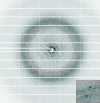Fast high-pressure freezing of protein crystals in their mother liquor
- PMID: 22505429
- PMCID: PMC3325829
- DOI: 10.1107/S1744309112009670
Fast high-pressure freezing of protein crystals in their mother liquor
Abstract
High-pressure freezing (HPF) is a method which allows sample vitrification without cryoprotectants. In the present work, protein crystals were cooled to cryogenic temperatures at a pressure of 210 MPa. In contrast to other HPF methods published to date in the field of cryocrystallography, this protocol involves rapid sample cooling using a standard HPF device. The fast cooling rates allow HPF of protein crystals directly in their mother liquor without the need for cryoprotectants or external reagents. HPF was first attempted with hen egg-white lysozyme and cubic insulin crystals, yielding good to excellent diffraction quality. Non-cryoprotected crystals of the membrane protein photosystem II have been successfully cryocooled for the first time. This indicates that the presented HPF method is well suited to the vitrification of challenging systems with large unit cells and weak crystal contacts.
© 2012 International Union of Crystallography. All rights reserved.
Figures





Similar articles
-
Practical macromolecular cryocrystallography.Acta Crystallogr F Struct Biol Commun. 2015 Jun;71(Pt 6):622-42. doi: 10.1107/S2053230X15008304. Epub 2015 May 27. Acta Crystallogr F Struct Biol Commun. 2015. PMID: 26057787 Free PMC article. Review.
-
High-pressure cooling of protein crystals without cryoprotectants.Acta Crystallogr D Biol Crystallogr. 2005 Jul;61(Pt 7):881-90. doi: 10.1107/S090744490500836X. Epub 2005 Jun 24. Acta Crystallogr D Biol Crystallogr. 2005. PMID: 15983410
-
A standardized technique for high-pressure cooling of protein crystals.Acta Crystallogr D Struct Biol. 2017 Dec 1;73(Pt 12):997-1006. doi: 10.1107/S2059798317016357. Epub 2017 Nov 22. Acta Crystallogr D Struct Biol. 2017. PMID: 29199979 Free PMC article.
-
Macromolecular crystal annealing: overcoming increased mosaicity associated with cryocrystallography.Acta Crystallogr D Biol Crystallogr. 1998 Jul 1;54(Pt 4):622-8. doi: 10.1107/s0907444997019008. Acta Crystallogr D Biol Crystallogr. 1998. PMID: 9761858
-
Macromolecular cryocrystallography--methods for cooling and mounting protein crystals at cryogenic temperatures.Methods. 2004 Nov;34(3):415-23. doi: 10.1016/j.ymeth.2004.03.032. Methods. 2004. PMID: 15325658 Review.
Cited by
-
Nanomedical Relevance of the Intermolecular Interaction Dynamics-Examples from Lysozymes and Insulins.ACS Omega. 2019 Feb 28;4(2):4206-4220. doi: 10.1021/acsomega.8b02471. Epub 2019 Feb 27. ACS Omega. 2019. PMID: 30847433 Free PMC article.
-
High-resolution X-ray crystal structure of bovine H-protein using the high-pressure cryocooling method.J Synchrotron Radiat. 2013 Nov;20(Pt 6):989-93. doi: 10.1107/S090904951302373X. Epub 2013 Oct 5. J Synchrotron Radiat. 2013. PMID: 24121354 Free PMC article.
-
AnACor2.0: a GPU-accelerated open-source software package for analytical absorption corrections in X-ray crystallography.J Appl Crystallogr. 2024 Nov 4;57(Pt 6):1984-1995. doi: 10.1107/S1600576724009506. eCollection 2024 Dec 1. J Appl Crystallogr. 2024. PMID: 39628882 Free PMC article.
-
Room-temperature macromolecular crystallography using a micro-patterned silicon chip with minimal background scattering.J Appl Crystallogr. 2016 May 23;49(Pt 3):968-975. doi: 10.1107/S1600576716006348. eCollection 2016 Jun 1. J Appl Crystallogr. 2016. PMID: 27275143 Free PMC article.
-
Practical macromolecular cryocrystallography.Acta Crystallogr F Struct Biol Commun. 2015 Jun;71(Pt 6):622-42. doi: 10.1107/S2053230X15008304. Epub 2015 May 27. Acta Crystallogr F Struct Biol Commun. 2015. PMID: 26057787 Free PMC article. Review.
References
Publication types
MeSH terms
Substances
Associated data
- Actions
- Actions
LinkOut - more resources
Full Text Sources
Other Literature Sources
Medical

